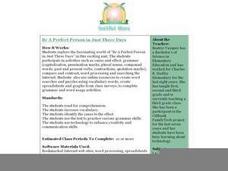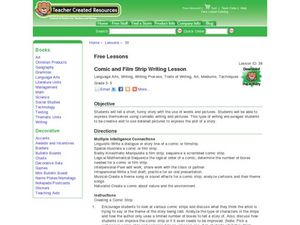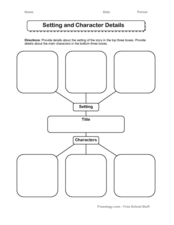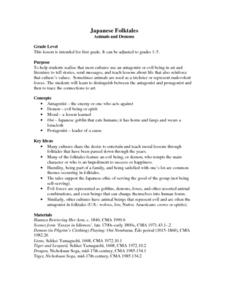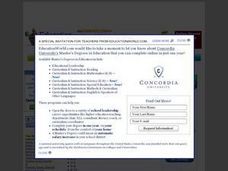Orange County Department of Education
The Lost and Found
Third graders explain the definition of integrity and respect and provide examples from the story The Lost and Found's characters and their own lives that illustrate both. They describe in their journals why and how they think Wendell...
Orange County Department of Education
Trapped by the Ice
Third graders read the story "Trapped by the Ice" which is about the Antarctic adventures of Sir Ernest Shackleton. They identify, write and share examples of respect and responsibility demonstrated by the stories' characters. Students...
Curated OER
Hooway for Wodney Wat
Students examine speech difficulties by reading a children's book in class. In this children's literature lesson, students read the story Hooway for Wodney the Wat, and analyze the characters, story and the bullying that takes place....
Curated OER
Reading the Biography
Students explore the lives of famous Americans. For this biography lesson, students read biographies about famous Americans and keep reading journals as they read about setting, main events, and character sketches.
Curated OER
Dreaming of Gardens
Students demonstrate ways to be an environmental philanthropist. In this philanthropy activity, students read The Gardener and Just a Dream and compare the two books. Students discuss ways the characters demonstrated environmental...
Curated OER
Characterization
Students read the book Sylvester and the Magic Pebble. In this character traits lesson, students read the book and identify character traits. Students draw pictures of a character from the book and describe the character traits.
Curated OER
Language Arts: A "Perfect" Lesson
Pupils read "Be A Perfect Person in Just three days," and participate in a host of activities. Connected to technology, they use online sources to create word searches and puzzles from vocabulary words. In addition, students create...
Curated OER
Writing a Story: Planning
In this rewriting a familiar story worksheet, students choose a familiar story and fill in the squares of a graphic organizer with new information about the characters, setting, story starter, ending. and/or main events. Students write 5...
Curated OER
Healthful Eating
Students read a story about how cartoon characters are partially to blame for American's obesity problem, and answer vocabulary and comprehension questions about it. In this healthful eating lesson plan, students respond to literature by...
Curated OER
Adapting a Fairy Tale
Students read and prepare a new oral version of a selected fairy tale. They read and compare/contrast two fairy tales and identify the main story elements. In small groups they create a new oral version of one they fairy tales and...
Curated OER
Let's Create a Picture
Students practice using visualization to aid in their reading comprehension. After a read aloud of a selected story, students write a brief summary of the plot accompanied by an illustration of the characters they have visualized.
Curated OER
Book Letters
Young scholars study language. In this writing lesson, students listen to a story and then compose a friendly letter, about the book, to a friend. They work independently to compose their letter depicting what happened in the...
Curated OER
The Three Little Pigs
Students listen two versions of the story of The Three Little Pigs in order to clarify the concept of point of view. They complete a Venn diagram and write a postcard to one of the book's characters using their point of view.
Curated OER
Comic and Film Strip Writing
Students write a funny story and illustrate it in a comic strip. In this comic strip lesson, students study comic strips and determine the plot of each story. Students then write a short story and illustrate it using a comic strip...
Curated OER
Tales From Around the World
Students read stories. In this culture lesson plan, students read stories from different regions around the world. Students look for each region on the map and listen for interesting cultural details in the story. Students then discuss...
Curated OER
Characterization
Students draw pictures to generate ideas about a character. They use prewriting skills to plan written work. They then dictate or write detailed descriptions of familiar person, places, objects, or experiences.
Curated OER
Yes, You Can!
Students examine the concept of encouragement. In this encouragement and character lesson, students participate in an active read aloud of Mary Grace's, Amazing Grace. They draw a picture in their journal of a time that they needed...
Curated OER
Setting and Character Details
In this setting and character worksheet, students provide details about the setting and character in this graphic organizer. Students provide 3 details for each.
Curated OER
Set the Scene
Third graders read the story "A Bargain for Frances" and make predictions about the unfolding plot of the story. In this set the scene lesson, 3rd graders examine the three parts of a story; the beginning, middle, and end.
Curated OER
BOOK REPORT FUN!
In this book report form, students are given names of literary elements (setting, problem/conflict, characters, main event, conclusion) in boxes. They are asked to complete short answers about each element in their book.
Curated OER
Book Report Fun- Blank Report Grid
In this book report learning exercise, students use blank boxes with titles to write about a book they have read. They will report about setting, characters, main events, conflicts, and conclusion. The boxes are unlined.
Curated OER
Japanese Folktales: Animals and Demons
Students compare and contrast the stories from different cultures by studying the folktales of Japan and their use of animals and antagonist characters. Any activity in this lesson can be used as a separate lesson.
Curated OER
Character and Plot Development Through Comics
Third graders are introduced to character, plot development, point of view, and tone through the use of comic strips. They, in pairs, identify these four attributes in the comic strip and present their findings to the class.
Curated OER
Celebrate Character Counts Week
Students participate in activities to celebrate character counts week. They identify the six pillars of character. They display good character when it comes to everyday tasks.
Other popular searches
- Setting Plot Main Characters
- Identify Main Characters
- Main Characters and Setting
- Main Character and Setting
- Identifying Main Characters
- Describing Main Characters
- Main Character Study
- Main Character Kindergarten
- Explaining Main Characters
- Defining Main Characters
- Developing a Main Character
- Reading for Main Character






